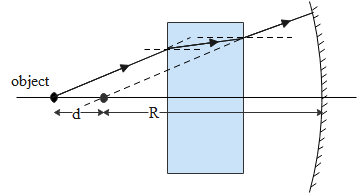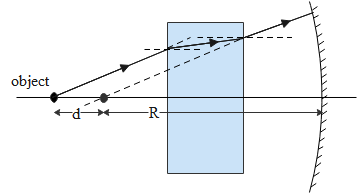
A slab of glass, of 6 cm and refractive index $\mu=1.5$ is placed in front of a concave mirror as shown in figure. If the radius of curvature of the mirror is 40 cm and the reflected image coincides with the object, then the distance of the object from the mirror is

A) 30cm
B) 22cm
C) 42cm
D) 38cm

Answer
568.5k+ views
Hint: Image made by a concave mirror coincides with the object in only one condition when the object is placed at centre of curvature means distance between mirror and object must be equal to radius of curvature. And also know that a glass slab object appears too shifted from their position and this shifted object works as an object of a mirror.
Complete step by step answer:
The given figure is,

We know when we see from glass slab then object appears to be shifted and this shift can be calculated by formula
$d = t\left( {1 - \dfrac{1}{\mu }} \right)$ This is the shift of object
Calculate shift of object due to mirror let d be the shift due to slab
$\mu = 1.5$ $t = 6cm$ Given in question
$ \Rightarrow d = 6\left( {1 - \dfrac{1}{{1.5}}} \right)$
Solving it
$ \Rightarrow d = 2cm$
So the shift of the object is 2 cm.
This image should work as an object of a concave mirror. In the question it is given that the image formed by the mirror must coincide with the object so the object must be placed at centre for curvature of the mirror, that is given 40cm.
Means that the total distance between object and mirror must be equal to the shift and radius of curvature
$D = d + R$
$\Rightarrow D = 2 + 40$
$\Rightarrow D = 42cm$
The distance of the object from the mirror is 42cm. Hence option C is correct.
Note:
In such types of question first calculate shift which depend on thickness of glass slab as well as refractive index of glass and we have to remind all positions of image formation of spherical mirror means as in this question given image should formed at the same place where object this is only possible in one condition in concave mirror. When an object is at the centre of curvature then image is formed at the centre of curvature.
Complete step by step answer:
The given figure is,

We know when we see from glass slab then object appears to be shifted and this shift can be calculated by formula
$d = t\left( {1 - \dfrac{1}{\mu }} \right)$ This is the shift of object
Calculate shift of object due to mirror let d be the shift due to slab
$\mu = 1.5$ $t = 6cm$ Given in question
$ \Rightarrow d = 6\left( {1 - \dfrac{1}{{1.5}}} \right)$
Solving it
$ \Rightarrow d = 2cm$
So the shift of the object is 2 cm.
This image should work as an object of a concave mirror. In the question it is given that the image formed by the mirror must coincide with the object so the object must be placed at centre for curvature of the mirror, that is given 40cm.
Means that the total distance between object and mirror must be equal to the shift and radius of curvature
$D = d + R$
$\Rightarrow D = 2 + 40$
$\Rightarrow D = 42cm$
The distance of the object from the mirror is 42cm. Hence option C is correct.
Note:
In such types of question first calculate shift which depend on thickness of glass slab as well as refractive index of glass and we have to remind all positions of image formation of spherical mirror means as in this question given image should formed at the same place where object this is only possible in one condition in concave mirror. When an object is at the centre of curvature then image is formed at the centre of curvature.
Recently Updated Pages
Master Class 12 English: Engaging Questions & Answers for Success

Master Class 12 Economics: Engaging Questions & Answers for Success

Master Class 12 Social Science: Engaging Questions & Answers for Success

Master Class 12 Maths: Engaging Questions & Answers for Success

Master Class 12 Chemistry: Engaging Questions & Answers for Success

Master Class 12 Business Studies: Engaging Questions & Answers for Success

Trending doubts
What are the major means of transport Explain each class 12 social science CBSE

Which are the Top 10 Largest Countries of the World?

Draw a labelled sketch of the human eye class 12 physics CBSE

Explain sex determination in humans with line diag class 12 biology CBSE

The pH of the pancreatic juice is A 64 B 86 C 120 D class 12 biology CBSE

Explain sex determination in humans with the help of class 12 biology CBSE




